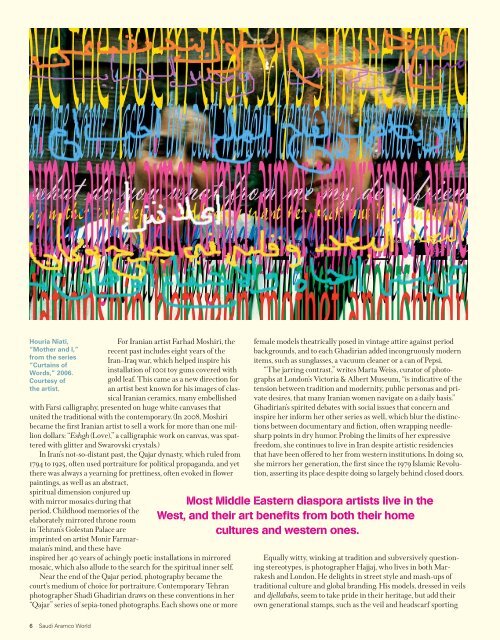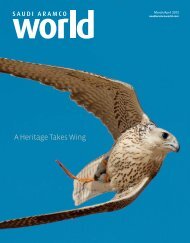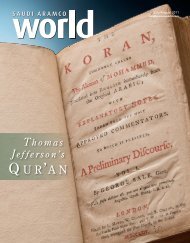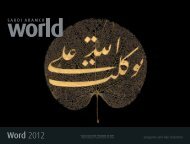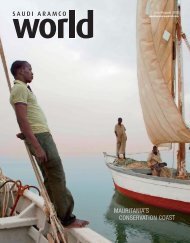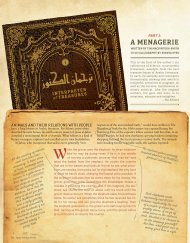MIDEAST - Saudi Aramco World
MIDEAST - Saudi Aramco World
MIDEAST - Saudi Aramco World
You also want an ePaper? Increase the reach of your titles
YUMPU automatically turns print PDFs into web optimized ePapers that Google loves.
Houria Niati,<br />
“Mother and I,”<br />
from the series<br />
“Curtains of<br />
Words,” 2006.<br />
Courtesy of<br />
the artist.<br />
For Iranian artist Farhad Moshiri, the<br />
recent past includes eight years of the<br />
Iran–Iraq war, which helped inspire his<br />
installation of 1001 toy guns covered with<br />
gold leaf. This came as a new direction for<br />
an artist best known for his images of classical<br />
Iranian ceramics, many embellished<br />
with Farsi calligraphy, presented on huge white canvases that<br />
united the traditional with the contemporary. (In 2008, Moshiri<br />
became the first Iranian artist to sell a work for more than one million<br />
dollars: “Eshgh (Love),” a calligraphic work on canvas, was spattered<br />
with glitter and Swarovski crystals.)<br />
In Iran’s not-so-distant past, the Qajar dynasty, which ruled from<br />
1794 to 1925, often used portraiture for political propaganda, and yet<br />
there was always a yearning for prettiness, often evoked in flower<br />
paintings, as well as an abstract,<br />
spiritual dimension conjured up<br />
with mirror mosaics during that<br />
period. Childhood memories of the<br />
elaborately mirrored throne room<br />
in Tehran’s Golestan Palace are<br />
imprinted on artist Monir Farmarmaian’s<br />
mind, and these have<br />
inspired her 40 years of achingly poetic installations in mirrored<br />
mosaic, which also allude to the search for the spiritual inner self.<br />
Near the end of the Qajar period, photography became the<br />
court’s medium of choice for portraiture. Contemporary Tehran<br />
photographer Shadi Ghadirian draws on these conventions in her<br />
“Qajar” series of sepia-toned photographs. Each shows one or more<br />
female models theatrically posed in vintage attire against period<br />
backgrounds, and to each Ghadirian added incongruously modern<br />
items, such as sunglasses, a vacuum cleaner or a can of Pepsi.<br />
“The jarring contrast,” writes Marta Weiss, curator of photographs<br />
at London’s Victoria & Albert Museum, “is indicative of the<br />
tension between tradition and modernity, public personas and private<br />
desires, that many Iranian women navigate on a daily basis.”<br />
Ghadirian’s spirited debates with social issues that concern and<br />
inspire her inform her other series as well, which blur the distinctions<br />
between documentary and fiction, often wrapping needlesharp<br />
points in dry humor. Probing the limits of her expressive<br />
freedom, she continues to live in Iran despite artistic residencies<br />
that have been offered to her from western institutions. In doing so,<br />
she mirrors her generation, the first since the 1979 Islamic Revolution,<br />
asserting its place despite doing so largely behind closed doors.<br />
Most Middle Eastern diaspora artists live in the<br />
West, and their art benefits from both their home<br />
cultures and western ones.<br />
Equally witty, winking at tradition and subversively questioning<br />
stereotypes, is photographer Hajjaj, who lives in both Marrakesh<br />
and London. He delights in street style and mash-ups of<br />
traditional culture and global branding. His models, dressed in veils<br />
and djellabahs, seem to take pride in their heritage, but add their<br />
own generational stamps, such as the veil and headscarf sporting<br />
6 <strong>Saudi</strong> <strong>Aramco</strong> <strong>World</strong>


